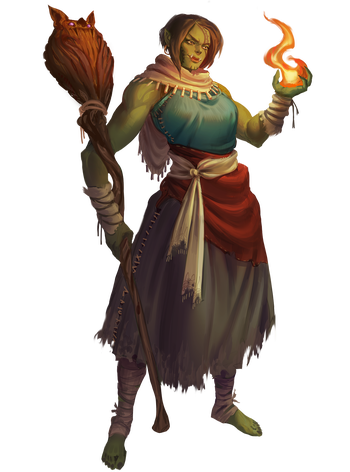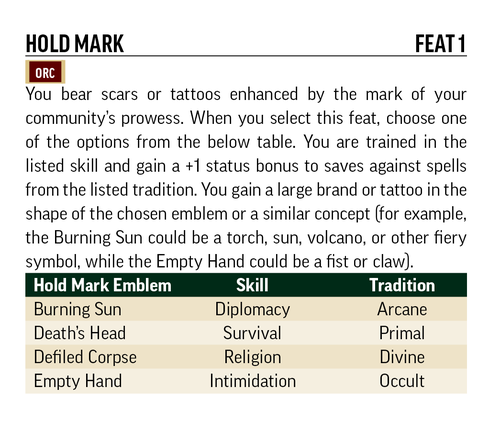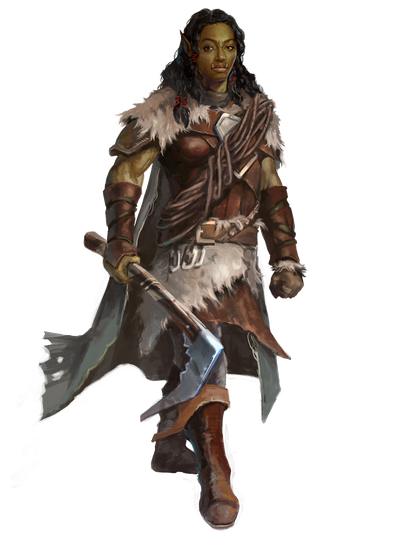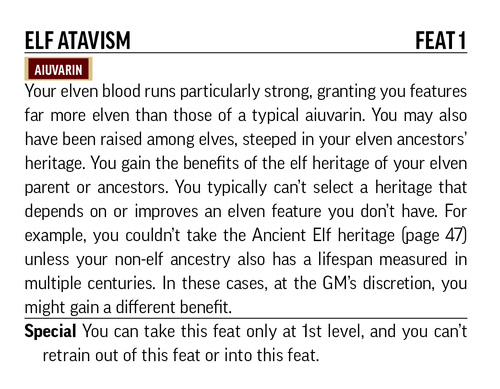As we cruise into the final days before the release, we’re getting to the end of these preview blogs, but we figured there’s probably still a few things we can talk about. How about orcs and the updated mixed ancestry rules?
Orcs are a common ancestry now, and appear among the Player Core options alongside dwarves, goblins, elves, humans, etc. This reflects not just a mechanical change, but also the ever-evolving state of our lore. With the undead hordes of the Whispering Tyrant seething outwards from the Gravelands, the orcs of Belkzen have seen their home transformed into one of the primary battlegrounds, raising their axes and torches high to fend off the encroaching darkness.

Illustration by Gabriel Scavariello
In becoming the vanguard of one of the greatest ongoing struggles threatening the Inner Sea, Belkzen’s orcs have also formed an ever-increasing number of alliances with their neighbors—something that is a source of contention for some of the less friendly holds…but that’s a story for later!
To help our new orcish allies with their battles, we’ve brushed up a few of their feats, as well. The old Hold Mark feat wasn’t great, especially in the context of some of the improvements we’ve made to ancestry feats; the Orc Weapon Familiarity feat now automatically gives you the benefits that used to require taking Orc Weapon Carnage as soon as you hit 5th level, without needing to spend any further feats. So, we reworked Hold Mark into a new 1st-level feat based on some of the orc holds of Belkzen that gives you training in a key skill and a constant bonus to saves against a specific type of magic—which does stack with the bonus from Orc Superstition, if you want to go that route, allowing orcs to be particularly resilient against certain types of magic!

As orcish heroes have spread across the Inner Sea, the opportunities for heroes of mixed orcish ancestry to carve out a place for themselves have also multiplied. Dromaars, as children of mixed orc and human ancestry are known in Belkzen, are one of the mixed ancestry examples provided in Player Core. The word dromaar is an orcish word, referring to those drummers whose music sends the hordes marching to war; many of the current generation of dromaar adventurers view themselves as heralds of a new age for orcs in the Inner Sea region.
While most dromaars from Belkzen have either one human parent and one orc parent or two dromaar parents, dromaars from other parts of Golarion might have some other ancestral mix; orcs and dwarves in Arcadia, for example, have a much more cooperative history together than the orc and dwarf nations of the Inner Sea, and it’s possible that the dromaars on that continent might have a significant population whose ancestry is of mixed dwarf and orc descent.

Illustration by Oleksii Chernik
Dromaars aren’t the only example of a mixed ancestry presented in Player Core; aiuvarins are people of mixed elven ancestry, typically having a human parent on one side and an elven parent on the other, though other mixes are entirely possible.
While introducing the aiuvarins, we took the opportunity to clean up some confusion around options like the Elf Atavism feat, which had some unclear interactions with things like the Ancient Elf heritage

Previously we’d presented options like aiuvarin and dromaar as human heritages, specifically half-elves and half-orcs. By pulling them out of the human ancestry and making them the first two heritages of the new Mixed Ancestry option, we open up a whole new world of possible options to customize your characters and your worlds. Currently, if you want to make a new Mixed Ancestry that represents people of partial dwarven, gnome, goblin, or other descent, you’ll need to use the example set by the aiuvarin and dromaar heritages to create your own, but in days to come I wouldn’t be surprised to see more mixed ancestry options appearing as we push back the edges of the map and do deeper explorations of Golarion’s other continents.
Michael Sayre
Design Manager